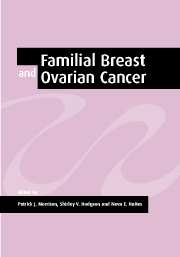Book contents
- Frontmatter
- Contents
- List of contributors
- Foreword by Helena Kennedy
- Preface
- Acknowledgements
- Part 1 Molecular biology and natural history
- Part 2 Screening
- Part 3 Management
- 15 Management of BRCA1/2 mutation carriers
- 16 Management of familial ovarian cancer
- 17 Prophylactic mastectomy in mutation carriers
- 18 Psychosocial aspects of genetic counselling for breast and ovarian cancer
- 19 BRCA1/2 testing: uptake and its measurement
- 20 Breast cancer genetics: ethical, social and insurance issues
- 21 Gene therapy for breast and ovarian cancer
- 22 Future directions
- Index
21 - Gene therapy for breast and ovarian cancer
Published online by Cambridge University Press: 24 August 2009
- Frontmatter
- Contents
- List of contributors
- Foreword by Helena Kennedy
- Preface
- Acknowledgements
- Part 1 Molecular biology and natural history
- Part 2 Screening
- Part 3 Management
- 15 Management of BRCA1/2 mutation carriers
- 16 Management of familial ovarian cancer
- 17 Prophylactic mastectomy in mutation carriers
- 18 Psychosocial aspects of genetic counselling for breast and ovarian cancer
- 19 BRCA1/2 testing: uptake and its measurement
- 20 Breast cancer genetics: ethical, social and insurance issues
- 21 Gene therapy for breast and ovarian cancer
- 22 Future directions
- Index
Summary
Introduction
Cancer results from a succession of genetic mutations that result in activation of oncogenes or inactivation of tumour suppressor genes. These changes can occur both early in the process of malignant transformation, and later, as the tumour becomes invasive. The success in the development of the technology for the transfer of genetic material into mammalian cells has raised the possibility of treating cancer at a molecular level. Despite initial enthusiasm, gene therapy has still not become a standard treatment modality for cancer. In this chapter we will review the approaches that have been attempted and consider why gene therapy is still an experimental approach.
Principles of gene therapy
Several strategies have been developed that involve the insertion of genetic material into cancer cells or immune cells involved in tumour cell kill. The success of these approaches depends on the ability to deliver the genetic material to the target cells. The transfer of genetic material to a cell is termed ‘transduction’ and the delivery systems used to transfer genes to target cells are called ‘vectors’. Transduction of adequate amounts of genetic material into tumour cells represents one of the most challenging areas of gene therapy, and vector technology is one of the most important areas of current research.
For a vector to be practical for everyday clinical use, it must be:
Easy to manufacture
Specific to tumour cells or host cells that may benefit from modification
Efficient at transducing genetic material
[…]
- Type
- Chapter
- Information
- Familial Breast and Ovarian CancerGenetics, Screening and Management, pp. 372 - 383Publisher: Cambridge University PressPrint publication year: 2002



